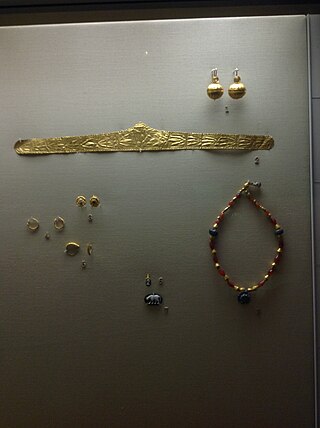Related Research Articles

Miletopolis or Miletoupolis (Μιλητούπολις) was a town in the north of ancient Mysia, at the confluence of the rivers Macestus and Rhyndacus, and on the west of the lake which derives its name from the town. It was a Milesian colony. Strabo mentions that a part of the inhabitants of the town were transferred to Gargara at some indeterminant time.
Blucium or Bloukion was a fortress of the Tolistoboii in ancient Galatia. It was the residence of Deiotarus, in defence of whom Cicero made an oration, addressed to the Dictator Caesar. In the text of Cicero, the name is read Luceium, and, accordingly, some translators amend Strabo by writing Λούκειον.
Polymedium or Polymedion, also known as Palamedium or Polymedia, was a small town in ancient Aeolis, between the promontory Lectum and Assus, and at a distance of 40 stadia from the former.
Poemanenum or Poimanenon was a Greek town of ancient Mysia, south of Cyzicus and on the southwest of Lake Aphnitis. It belonged to the territory of Cyzicus was well fortified, and possessed a celebrated temple of Asclepius. Other writers call the town Poemanenus or Poimanenos (Ποιμανηνός) or Poemanentus or Poimanentos (Ποιμάνεντος). Its inhabitants are called Poemaneni (Ποιμανηνοί) According to the Notitiae Episcopatuum, it became a bishopric. No longer a residential see, it remains a titular see of the Roman Catholic Church. Nearby was fought the Battle of Poemanenum in 1223 or 1224.
Cratia, Crateia or Krateia was a town in the interior of ancient Bithynia, which also bore the name Flaviopolis, which clearly dates from the imperial period, and probably the time of Vespasian. The Antonine Itinerary places it between Claudiopolis and Ancyra of Galatia, 24 M. P. from the former. An autonomous coin with the epigraph κρη is attributed to this place; and there are coins of the imperial period, from Antoninus Pius to Gallienus. It became an episcopal see. Under the name Cratia it remains a titular see of the Roman Catholic Church. It may also have borne the name Agrippeia.
Mnizus or Mnizos, or Minizus or Minizos, was a small town in ancient Galatia, between Lagania and Ancyra, where the Emperor Anastasius must have lived for some time, as several of his constitutions are dated from that place, both in the Codex Theodosianus and the Codex Justinianeus. It appears in the Notitiae Episcopatuum as a bishopric. It also appears, under the name Rhegemnezus or Rhegemnezos (Ῥεγέμνηζος) in the Synecdemus. It appears as Mizagus in the Tabula Peutingeriana. No longer a residential bishop, Mnizus remains a titular see of the Roman Catholic Church.
Peium or Peion, also known as Peon, was a fortress of the Tolistoboii in ancient Galatia, where Deiotarus kept his treasures.
Ergobrotis was a town of ancient Galatia, inhabited during Byzantine times. Its name does not occur among ancient authors, but is inferred from epigraphic and other evidence.
Artiknos was a town of ancient Galatia, inhabited during Roman times. Its name does not occur among ancient authors, but is inferred from epigraphic and other evidence.
Carus Vicus was a town of ancient Bithynia. It was on the main road from Claudiopolis through Cratia (Flaviopolis) and Carus Vicus to Ancyra in Galatia. It was 30 M.P. from Cratia.
Mantineion was a town of ancient Bithynia, inhabited in Roman and Byzantine times.
Antoniopolis was a town of ancient Paphlagonia, inhabited in Roman and Byzantine times.
Karza was a town in the borderlands between ancient Bithynia and Paphlagonia, inhabited in Roman times. The name does not occur among ancient authors but is inferred from epigraphic and other evidence.
Endeira was a town in the borderlands between ancient Bithynia and Paphlagonia, inhabited in Roman times. The name does not occur among ancient authors but is inferred from epigraphic and other evidence.
Zeita was a town of ancient Anatolia in the borderlands between ancient Bithynia and Paphlagonia, inhabited in Roman times. The name does not occur among ancient authors but is inferred from epigraphic and other evidence.
Kindyria was a town of ancient Lycaonia, inhabited in Roman and Byzantine times. The name does not occur among ancient authors but is inferred from epigraphic and other evidence.
Mourisa was a town in the borderlands between ancient Isauria and Lycaonia, inhabited in Roman times. The name does not occur among ancient authors but is inferred from epigraphic and other evidence.
Astra was a town of ancient Isauria, inhabited in Roman times. The name does not occur among ancient authors but is inferred from epigraphic and other evidence.
Olosada was a town of ancient Cilicia, inhabited in Roman times. The name does not occur among ancient authors but is inferred from epigraphic and other evidence.
Conium, also called Conni, Conna, Konna, Kone, Cone, Demetrioupolis and Demetriopolis, was a town of ancient Phrygia Magna. According to the Peutinger Table, where the town name appears as Conni, it was located between Eucarpia and Nacolea, 32 Roman Miles from Eucarpia and 40 from Nacolea. Pliny the Elder calls the town Conium; Ptolemy calls it Conna or Konna. Under the Byzantine empire the town was called Cone or Kone, and was a bishopric of Phrygia Salutaris, of which Synnada was the metropolis. No longer the seat of a residential bishopric, it remains, under the name Cone, a titular see of the Roman Catholic Church.
References
- 1 2 3 Richard Talbert, ed. (2000). Barrington Atlas of the Greek and Roman World . Princeton University Press. p. 86, and directory notes accompanying. ISBN 978-0-691-03169-9.
- ↑ Lund University. Digital Atlas of the Roman Empire.
40°59′03″N32°35′08″E / 40.98429°N 32.585455°E